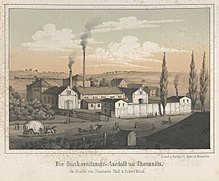Chemnitz-Altchemnitz
|
Altchemnitz district and statistical district No. 41 of Chemnitz |
|
|---|---|
| Coordinates | 50 ° 48 '45 " N , 12 ° 54' 50" E |
| surface | 5.01 km² |
| Residents | 5821 (Dec. 31, 2013) |
| Population density | 1162 inhabitants / km² |
| Incorporation | Oct. 1, 1894 |
| Post Code | 09111, 09120, 09125, 09126 |
| prefix | 0371 |
| Transport links | |
| Federal road |
|
| tram | 5, C11. |
| bus | 43 / E43, 53, E53, 208, 210, 211, N14. |
Altchemnitz is a district in the south of Chemnitz . The district was incorporated on October 1, 1894.
Geography and traffic
In the extreme south of this district, the Zwönitz and Würschnitz flow together to form the Chemnitz River at the level of Harthauer Strasse . At this point, a bridge connects the two neighboring districts of Altchemnitz and Harthau. Not far from there is also the terminus of tram line 6 , on the area of which the former “Reichels Neue Welt” restaurant was once located. The “Chemnitz-Zwönitzbrücke” stop on the Zwönitz – Chemnitz Süd railway line was also not far from the tram's terminus . Since 2002, the Chemnitz City Bahn trains have been running on the tram tracks to the Altchemnitz turning point and from here via a short, newly built link to the Zwönitz – Chemnitz Süd railway line and on to Stollberg / Erzgeb. Since then, the Zwönitzbrücke – Chemnitz Süd section of the aforementioned railway line has only been used for freight traffic and for transfer trips, but no longer for regular local rail passenger traffic.
The B 95 (Annaberger Straße) leads through Altchemnitz . In the west, the district borders the Chemnitz River. Furthermore, the Altchemnitzer Flur is bounded by the center in the north, Bernsdorf , Reichenhain and Erfenschlag in the east and Harthau in the south. If you disregard the Chemnitz River, Altchemnitz also borders the Markersdorf , Helbersdorf and Kapellenberg districts to the west .
history
Altchemnitz was first mentioned as a single row forest hoof village , belonging to the Chemnitz Benedictine monastery , around 1200 as "Antiqua Kemnitz". Another mention comes from the year 1311 ("Alden Kempnitz"). The place was described as an older settlement compared to the younger city of Chemnitz. The first settlers are wolf hunters, whose property must have been located roughly at today's tram end stop 6. After the secularization of the Chemnitz monastery (1548), there was a small exclave in Altchemnitz until 1831, which was part of the Rochlitz office instead of the Chemnitz office , to which Altchemnitz now belonged . Altchemnitz developed into an industrial location early on. Already in the 1820s there was a brisk factory activity along the Chemnitz River as far as the city of Chemnitz. The last farmsteads in Altchemnitz disappeared by 1884, but larger factories were built, including that of the iron goods manufacturer Rowac , which the company moved into in 1920. The Chemnitz tram has been running to the upper part of the town since 1900 .
Important buildings
In Altchemnitz are u. a. the regional directorate Saxony , the shopping center “Altchemnitz-Center” (ACC, Annaberger Straße), the “Europark” with the State Archives Chemnitz (Schulstraße), the “Arbeitsagentur” (Heinrich-Lorenz-Straße) and the “Wirkbau” (Lothringer Straße) as well as the former municipal gas works (Saydaer Straße, today the Bernsdorf district).
literature
- Jörn Richter (Ed.): From the Wolfsjägersiedlung to the high-tech location - a Chemnitz district history of Altchemnitz and the surrounding area. Verlag Heimatland Sachsen: Chemnitz, 2001 ISBN 3-910186-32-7
- Richard Steche : Altchemnitz. In: Descriptive representation of the older architectural and art monuments of the Kingdom of Saxony. 7th issue: Amtshauptmannschaft Chemnitz . CC Meinhold, Dresden 1886, p. 3.
See also
Web links
- Altchemnitz in the Digital Historical Directory of Saxony
- From the history of the district
Individual evidence
- ↑ http://hov.isgv.de/Altchemnitz
- ↑ http://hov.isgv.de/Altchemnitz
- ↑ Company history. In: www.bemefa-simco.com. bemefa GmbH, accessed on August 17, 2016 .







